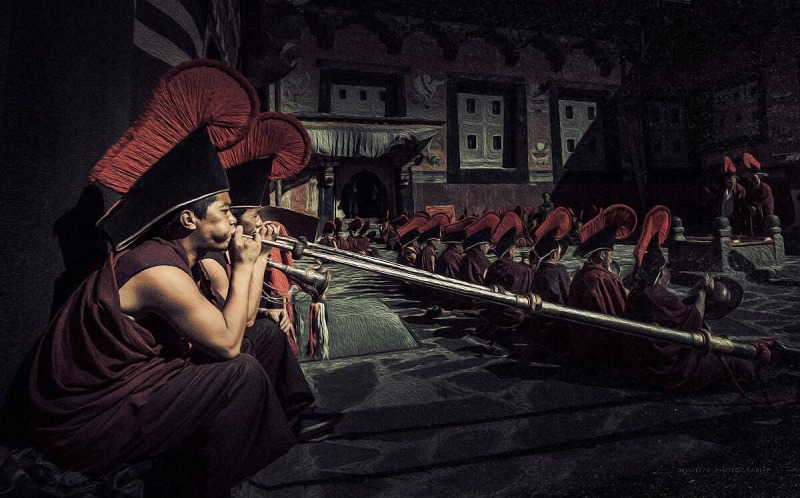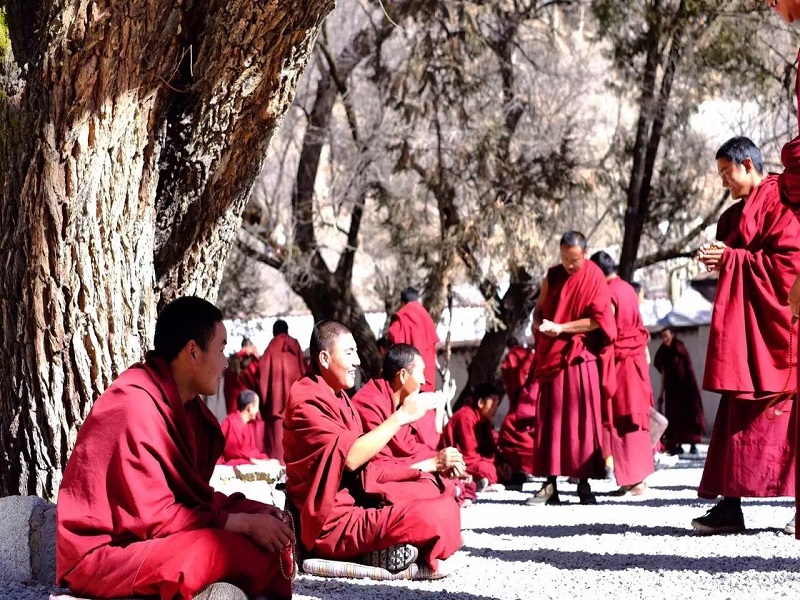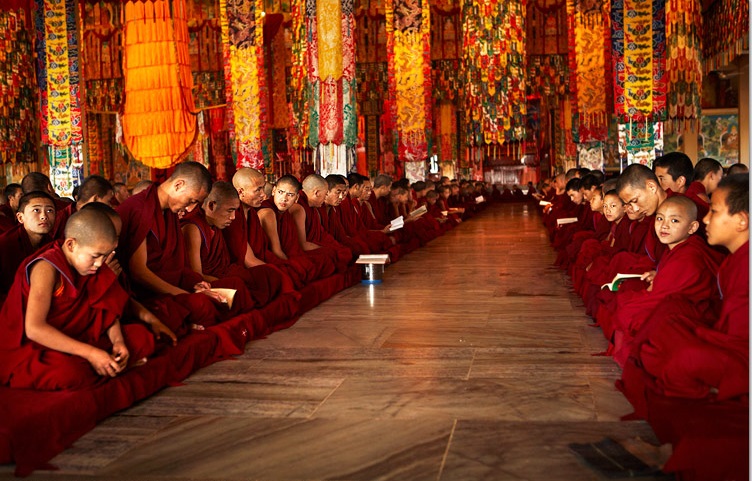Tibetan Monks
- by Eric
- Last Updated: 2024-09-10
Tibet is a holy land of Buddhism that attracted hundreds of tourists to travel to explore its profound Buddhist culture. In the past, the ratio was that 1 in 6 Tibetan men were Buddhist monks. Do you wanna know what the life-like of the mysterious Tibetan monks or have you ever imagined the inside picture of Buddhist monasteries?
Actually, Tibetan monks lead a simple and fairly peaceful life. By all means, They are dedicated to prayer and serving others and they will feel content and pleasure. Tibetan monks would never pursue the material comforts; their food is simple, involving some Tibetan bread, vegetables and loads of Tibetan tea. The Tibetan monks get along well with each other. Usually they joke with each other and talk with each other.

Monk in the Tibetan language is "trapa," which means “student” or “scholar." There are three kinds of Tibetan monks residents in the monastery, including monks, scholars, and lamas. Lamas are considered spiritual guides and masters who teach meditation techniques to disciples. In Tibetan Buddhism, they are regarded as "living gods" who possess supernatural powers that can slay demons and bring good fortune, wealth and good health. Without a doubt, Tibetan monks play a significant role in the lives of the Tibetan people. They not only conduct religious ceremonies but also take care of the monasteries.
The Scholastic Life of Tibetan Monks
Small monks start their scholastic life in the monastery where they will learn all the monastic disciplines, and customs in monasteries and learn how to spell Tibetan Buddhist mantras and recite some basic prayers. And they need to serve their mentor or master for 3 years. Besides, they are going to take care of the chores of the monastery. Later, they will begin to start the 5 Buddhist classics, including Buddhist Logic, Heart Sutra, Madhyamika, Monastic Discipline, and Kusha-shū. Three years per course, and they need a total of 15 years of study. After passing the rigorous examination, they enter the Gyumé Lower Tantric College, then the Gyuto Upper Tantric College, and finally become lamas, usually over forty years old.
Each monk is given two commandments, the Sami at the age of 10 and the bhikkhu at the age of 20. Under the auspices of the high monk living Buddha, the ordained person makes a solemn oath in front of the sutras and Buddhas to abide by the precepts and practices for the sentient beings.

The Daily Life of Tibetan Monks
Lamas are students living in Tibetan areas. Through the accumulation of knowledge and faith, complete the "pilgrimage road" in life.
The life of the lama begins early in the morning. The lamas, led by their leaders, say morning prayers in the hall. The morning prayer lasts about 2-3 hours, during which, for three times, hundreds of young monks line up to pour butter tea and "tuba" porridge in the prayer hall. The monks eat and drink while chanting sutras, which is very interesting. After the morning praying, breakfast finishes. The next prayer is about 9 to 10 o 'clock, the lamas return to Zhacangs Hall to chant sutras and drink tea; At 3 or 4 o 'clock in the afternoon, each lama gathers in their Khangtsen (dorm) to chant sutras and drink tea.
In addition to the three prayer sessions, there are also three debate sessions per day.
In Tibetan monasteries, it is common for Tibetans to provide tea and porridge to monks. And in return, the monks chant the scripture for them. Monks would pray for happiness for a family or pray for rest and peace for a deceased family member. After the chanting, the related family would offer some money to the monks as a particular way of giving.
Tibetan Monks live the same life. They read Buddhist scriptures, turn prayer wheels, and Kowtow day after day, year after year to practice their extremely devoted beliefs.
Most Tibetan monks live in 10 famous temples and monasteries such as the Jokhang Temple, Drepung Monastery, Sera Monastery, Tashilunpo Monastery, etc. You may have a glimpse of the top ten temples and monasteries in Tibet.

Living Buddhas
Living Buddha in the Tibetan language is "Tulku," which means reincarnation. The reincarnation system of living Buddhas is the most noticeable feature that distinguishes Tibetan Buddhism from other Buddhist schools. Living Buddha refers to a monk who has made some achievements in religious practice. After the establishment of the reincarnation system, it has become a common way of inheritance adopted by all sects of Tibetan Buddhism.
The daily life of a young living Buddha is similar to that of a high school student. Morning classes begin at 6 a.m., followed by sutras and Buddha worship. Every day before breakfast, they recite the Buddhist sutras. In the morning, they generally touch the top for the Buddha to bless the believers and then study the sutras. After lunch, they have a half-hour lunch break, and in the afternoon they continue to follow the teacher. In the dusk, they would discuss scriptures with other monks and learn from each other. In the evening, they would do homework until late at night.
If you are paying a visit to a living Buddha, you may offer a khata to the living Buddha. Please bow over your head and offer the khata with both hands. Then the living Buddha will take the khata or take it and put it around your neck. You can't point your finger at the living Buddha. In a word, respect is the most important.
Related Articles
- Sacred Lakes of Tibet
- Kunlun Mountains
- Tibetan People
- A Brief Introduction to Tibet
- Climbing Mount Kailash: Is Mount Kailash Climbable?
- Tibetan Sound Bowls
- Tibetan Monk Hat
- 20 Pictures Will Inspire You to Travel to Tibet
- Top Five Main Beliefs of Tibetan Buddhism
- Tibetan Handicrafts
Email response within 0.5~24 hours.



Typically Asked Questions from Our Clients
Asked by Melo***
After years of delving into Jesus gnostic teachings, Lao Tzu The Way, I feel that learning Buddha and the Buddhist way and leaving technology and materialism behind would help me to further my spiritual development
Dear Melo****,
It’s truly inspiring to hear about your deep exploration of different spiritual traditions, from Gnostic teachings and Lao Tzu’s wisdom to now embracing the Buddhist path.
Buddhism offers a profound way to detach from materialism and technology, allowing for inner peace and deeper self-discovery. If you are considering a retreat or pilgrimage to immerse yourself in Buddhist teachings, places like Tibet, Nepal, or Bhutan provide incredible opportunities to experience authentic monastic life, meditation practices, and spiritual teachings.
Asked by Glri***
If a tibetan Monk decides to leave and get married what is the ceremony like at the temple.
Dear Glria, According to what we know, there's no ceremony if a Tibetan monk wants to get back to the secular.
Asked by Deir***
I was hoping to visit the monks and stay for a while to see if to be a monk was what I was searching for.
Regards,
Dee
Dear Deir**, You may visit Tibet and stay at some monasteries during the daytime. You can see their daily lives instead of being one of them. There're very strict policies for foreigners staying at monasteries.
Asked by Tina***
Do the Monks pray daily for World Peace and elevation of humanity, to bring absolute joy and end all suffering great and small for humankind?
Dear Tina, This is Beatrice from Great Tibet Tour at your service. You are right, Tibetan monks are praying for world peace and for people to be free from suffering.